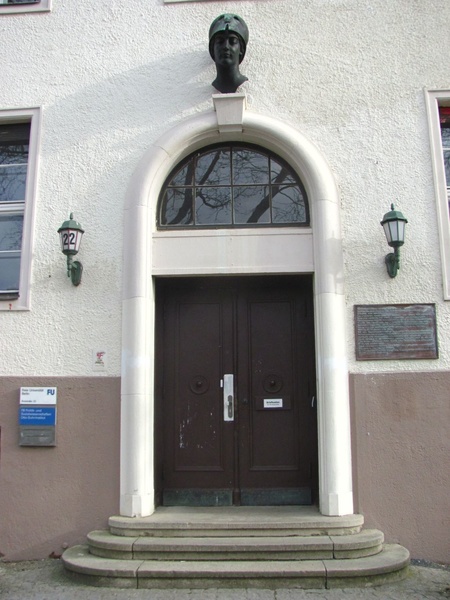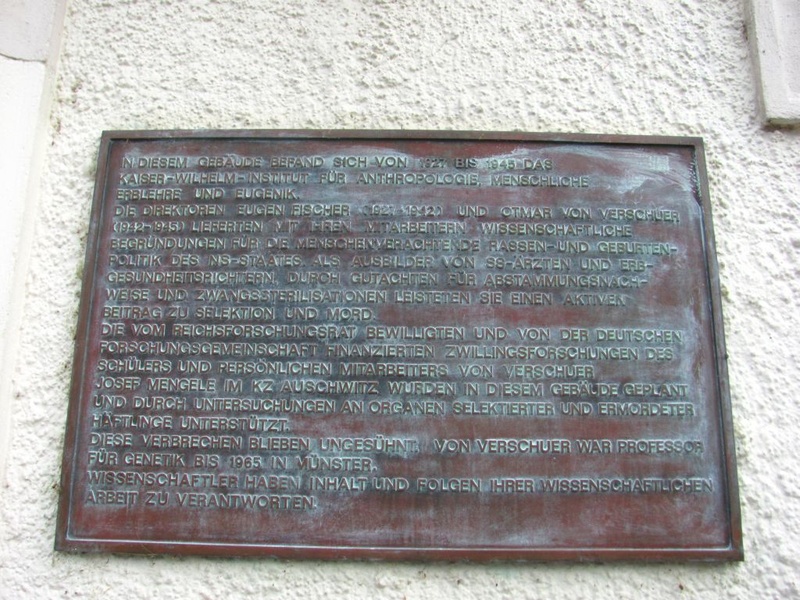Being Remembered
Memorial Plaque
The History
The memorial plaque, located at the main entrance of Ihnestraße 22, was installed in 1988. Its installation was the result of several years of research and activism by scientist and staff of the Otto Suhr Institute for Political Science as well as independent researchers.


For a long time, not much was known about the history of the building at Ihnestraße 22 and the connections of the former Kaiser Wilhelm Institute for Anthropology, Human Heredity and Eugenics (KWI-A) to colonialism and National Socialism. Neither the Max Planck Society (MPG), the successor institution of the Kaiser Wilhelm Society, nor the Free University of Berlin officially acknowledged this historical connection after World War II. Doctoral student Anna Bergmann looked into the history of the institute in 1983 and tried to initiate a discussion about the
racist history at the Otto-Suhr-Institute. Since research on medical crimes under National Socialism and the history of racial hygiene was still in its infancy at the time, nothing happened at first.
Only when the well-know human geneticist Benno Müller-Hill suggested a memorial plaque in 1985 based on his research (author of Tödliche Wissenschaft. Die Aussonderung von Juden, Zigeunern und Geisteskranken 1933-1945), the university administration took first steps towards a possible remembrance.
Meanwhile, Anna Bergmann, Christl Wickert and other researchers had continued their research of this history in the archives. In the process, they repeatedly encountered resistance and Anna Bergmann was banned from the MPG archives.
Dr. Christl Wickert describes her research at the MPG archives:
“The few files that we were presented with in 1985 were still in old file cases, [where] remains of cut out file pieces [were] clearly visible… Assistance from the archive in the search for further evidence was rejected by the archivist with the reasoning that the MPG did not have any interest at all in the history of the Kaiser Wilhelm Institute during the Nazi period, as it was not part of the MPG history and the archival materials were simply transferred.”
After the department council of the Otto-Suhr-Institute passed a text proposal for a memorial plaque in 1986, further discussions and disputes about the exact contents of the plaque followed, including with the executive office of Freie Universität and the MPG. Since there were differences between the MPG and the institute regarding the content of the plaque, nothing happened for a while. Being frustrated by this lack of action, a scientific working group (short: project group) designed a concept for a permanent exhibition and independently installed a first memorial plaque on the building in September 1987. This plaque was then officially replaced by the Freie Universität Berlin with today's plaque on June 15, 1988.
Anna Bergmann recalls:
"Götz Aly, Gabriele Czarnowski, Annegret Ehemann, Susanne Heim and I drafted the wording for a memorial plaque, proposed by Benno Müller-Hill, based on years of research we had done and which was systematically obstructed by the MPG at the time. We installed a plaque at our own expense on September 15, 1987, without permission from the President's Office, and called a press conference with great support from the former Dean, Prof. Dr. Ulrich Albrecht. I had originally been approached by the departmental council of the Otto Suhr Institute about the wording of a memorial plaque because, as a doctoral student and lecturer at this institute, I had already informed them through a letter dated back to November 18, 1983 that the Kaiser Wilhelm Institute for Anthropology, Human Heredity and Eugenics had been located in the house at Ihnestraße 22, after I had come across the letterhead of the KWI at Ihnestraße 22 in a file in the Federal Archives Koblenz as part of my dissertation on the history of racial hygiene and eugenics in the German Empire. "
Although the project group's proposed wording was adopted almost in its entirety, two crucial sentences are missing from the memorial plaque that remains installed to this day: After 1945, the perpetrators - with few exceptions - continued their scientific careers. Their research findings are still used by medical science today. Instead, reference is made only to Verschuer's further teaching activities and the personal responsibility of the scientists.
The bronze plaque still hangs at the front entrance of the building Ihnestr. 22.
Interview with Christl Wickert (Audio)
Research Program
History of the Kaiser Wilhelm Society in the National Socialist Era
From 1999 to 2004, a research program was commissioned by the Max Planck
Society (MPG) to examine the role of the Kaiser Wilhelm Society (KWG) – now the
MPG – and the relations of its research staff to the Nazi regime. The research
program’s intention was to critically examine the history of the KWG and was
directed by Prof. Carola Sachse from 2000 to 2004. The research program
concluded in 2005 and produced numerous publications, which primarily consist
of 17 books. These investigate the researchers, their involvement in Nazi
politics as well as the research conducted including experiments on humans
conducted at the different research institutes of the KWG. One particular focus
was the Kaiser Wilhelm Institute for Anthropology, Human Heredity and Eugenics
(KWI-A) and its connection with Josef Mengele and the Auschwitz concentration
camp. The goals of the research program include the exploration of science as
legitimizing Nazi “racial” policy, the impact of expert knowledge production on
politics and the violation of ethical boundaries within research. The role of
German colonialism, however, was not included in the MPG’s research
program.
Project director, Benoit Massin, describes the content of the KWI-A’s research
as follows: “‘Race’ was a concept central to Nazi ideology and politics. Much -
if not most - of what seems to us characteristic in the criminal dimension of
Nazism was committed ‘in the name of race’. Most German scientists in the field
of human genetics and racial anthropology failed to challenge the Nazi effort
to found state-policies on racial biology, asserting that Nazism itself was
simply ‘applied racial science’. Nazism thus brought the ‘sciences of race’
(Rassenkunde, Rassenforschung, Rassenbiologie) to center stage. Prof. Eugen
Fischer, for example, saw the budget of his institute [KWI-A] more than double
under the new regime. In turn, he promised Nazi authorities that the institute
would devote itself both ‘to providing a solid scientific basis to the racial
[...] policy measures of the new state and to the practical applications’ of
this racial policy'."
Source:
- Massin, B. (2000). Racial Science and Racial Politics in the "Third Reich": The Kaiser Wilhelm Institute for Anthropology, Human Genetics and Eugenics (1933-1945). Retrieved from http://www.mpiwg-berlin.mpg.de/KWG/projects_e.htm#Rassenforschung
Interview with Prof. Carola Sachse (Audio)
Interview with Prof. Hans-Walter Schmuhl (Audio)